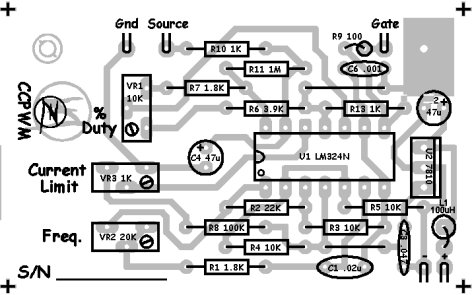| You are here: |
|
- Home
- FAQ
- Zero Labs Store
- Plans & Schematics
- Tell-A-Friend
- Latest News
- Hall of Fame
- Links Page
- Event calendar
- Product reviews
- Alt-Nrg Forum
- Video Vault
- Zero Live!
Get
my instant news
alerts now on Twitter!
![]()
| PWM Parts List | ||||||
|
The Zero Fossil Fuel Constant Current PWM v2.1 This is a slightly modified version of the first PWM. The basic circuit is the same. Some component values have changed. And it's laid out specifically to fit in a Velleman G106 sealed die cast aluminum enclosure measuring 4.5" L x 2.5" W x 1.25" H. Bud and Deltron also make very nice die cast aluminum cases. |
|
||||||||||||||||
|
Circuit description: U1 is a LM324N quad op-amp. U1A and U1B form
a triangle wave generator. The output voltage swing is approx. 1/3-2/3 Vcc. The
output is fed to comparator U1C which turns it to square wave based on the threshold
voltage at pin 10. The duty cycle threshold is set by VR1. R6 and R7 are calibrated
to give full range duty cycle adjustment of VR1. The voltage reference for R7
is normally held at Vcc by the output of current limiting error amp U1D. Gain
is set at 1000 (subject to change depending on how stiff I want the current to
limit). Any time the source of Q1 draws current a voltage drop occurs across R12.
80 amps will give 120mV, the max setting on VR3. If the voltage drop across R12
exceeds the preset value of VR3, the comparator drops the PWM duty cycle until
the average is just less than the preset value. C4 ensures that the current limiting
is average not peak.
To set your PWM to limit current you will need some way of measuring the large current being drawn by your load. You can buy ammeters that have external shunts for this purpose for around $30, just the shunt alone if you have a digital multi-meter for about the same price, you can build your own shunt as I've shown in video #43 for mere pennies, or you can get a clamp on DC ammeter as I did for around $80 from Harbor Freight.
Done! As the cell heats up, peak current will rise but duty cycle will fold back an equal amount to keep the RMS current constant. You should also view my video #119 prior to operation. Have fun! |
|||||||||||||||||
| Contact | Legal |




